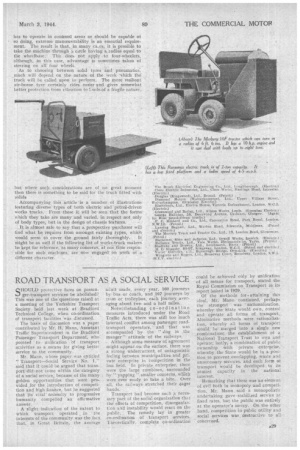ROAD TRANSPORT AS A SOCIAL SERVICE
Page 31

If you've noticed an error in this article please click here to report it so we can fix it.
SI-IOULP protective fares on ,passenger7transport services be abolished?. This was one of the questions raised at a meeting of the •Yorkshire Transport Society held last. -.week at Bradford Technical College, when co-ordination of transport facilities 'was discussed.
The basis of discussion was a paper contributed by Mr. Mann, Assistant Traffic Superintendent in the Bradford Passenger Transport Department, who pointed • to uuification transport activities as a means for giving better Service to the community.
Mr. Mann, whose paper was entitled '! Transport—Social Service No. 1," said that it could be argued that trans-, port did.not come within the category of a social service, because of the many golden opportunities that were pro vided for the introduction of competition and high finance, but he suggested that its' vital' necessity to progressive humanity compelled an affirmative answer. ' • • A slight indication of the extent to which transport operated , in the
interests-of the community.was the fact that, in Great Britain, the average
adult made, every year, 160 journeys by bus or coach, and .197 journeys by train or trolleybus, each journey averaging about two and a half miles.
Notwithstanding co-ordination measures introduced under the Road Traffic Acts, there was still too -much internal conflict among passenger roadtransport operators, and that was accompanied by the " dog in . the manger" attitude of the railways,
• Although some measure of agreement might appear on the surface, there was a strong undercurrent of antagonistic feeling between municipalities and private enterprise in competition in the bus field. In private enterprise; there were the large combines, surrounded by " yapping " smaller concerns, whith were ever ready to take a bite. Over all, the railways stretched their eager hands., . Transport had become such a necessary pant of the social organization that the' effects of competition, disorganization and instability Would react on the public. The remedy lay in greater .co-ordination of transport services. Theoretically, complete co-ordination could be achieved only by unificatiou of all means for transport, stated the Royal Commission on Transport in its report issued in 1929.
Of the methods tor-attaining this ideal, Mr. Mann continued, perhaps the' strongest was nationalization, whereby theState would own, control and operate all forms of transport. Alternative methods were rationalization, whereby all forms of transport would be merged into a single new combination; the establishment of a National Transport Trust to own and Operate; lastly; a combination of public ownership with private enterprise. whereby the State would be in a position to prevent overlapping, waste and . unnecessary services, and each form of transport would be developed to its utmost capacity in the national
interest. •
Remarking that there was an element of evil bbth in monopoly and competition, Mr. Mann . said a monopolistic undertaking gave -stabilized service *at fixed rates, but the public was entirely at the operator's mercy. On the other hand, competition in public utility and social services was destructive to all concerned. •




















































